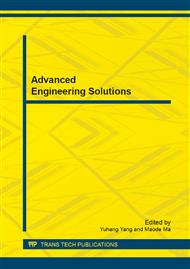p.819
p.823
p.827
p.832
p.838
p.843
p.850
p.855
p.860
Ecological Aquaculture Wastewater Purification Engineering Design of Microcirculation Running Water Breeding System
Abstract:
This study finds that the four kinds of aquatic plants of Ipomoea aquatica (IA), Eichhornia crassipes (EC), Alternanthera philoxeroides (AP) and Sagittaria sagittifolia (SS) have the significant effect on the purification of aquaculture wastewater through the contrast monitoring in the outdoor natural environment condition. The removal rates of the four kinds of aquatic plants are 91.37%, 94.27%, 58.64%, 90.26%, 92.67%, 100%;87.41%, 94.69%, 54.09%, 82.82%, 88.36%, 100%;83.09%, 94.91%, 51.36%, 86.67%, 87.36%, 100%;93.52%, 95.59%, 60.45%, 90.68%, 93.58%, 100% respectively to TN, TP, CODMn, NH4+-N, NO3--N, NO2--N in 10d trial period. On this basis, this study uses the aquatic plants, ozone measurement and control instrument and pump to build an ecological aquaculture wastewater purification system, it is applied in the high density running water breeding of the Clarias leather, channel catfish, grass carp and Odontobutis potamophila. We harvest the adult fish 47.2 Kg per square meter, the output value is 566.91 yuan and the profit is 136.76 yuan, so it has the significant economic and ecological benefits and it explores a new model for the development of "water-saving, zero emissions" aquaculture.
Info:
Periodical:
Pages:
838-842
Citation:
Online since:
July 2014
Authors:
Price:
Сopyright:
© 2014 Trans Tech Publications Ltd. All Rights Reserved
Share:
Citation:


